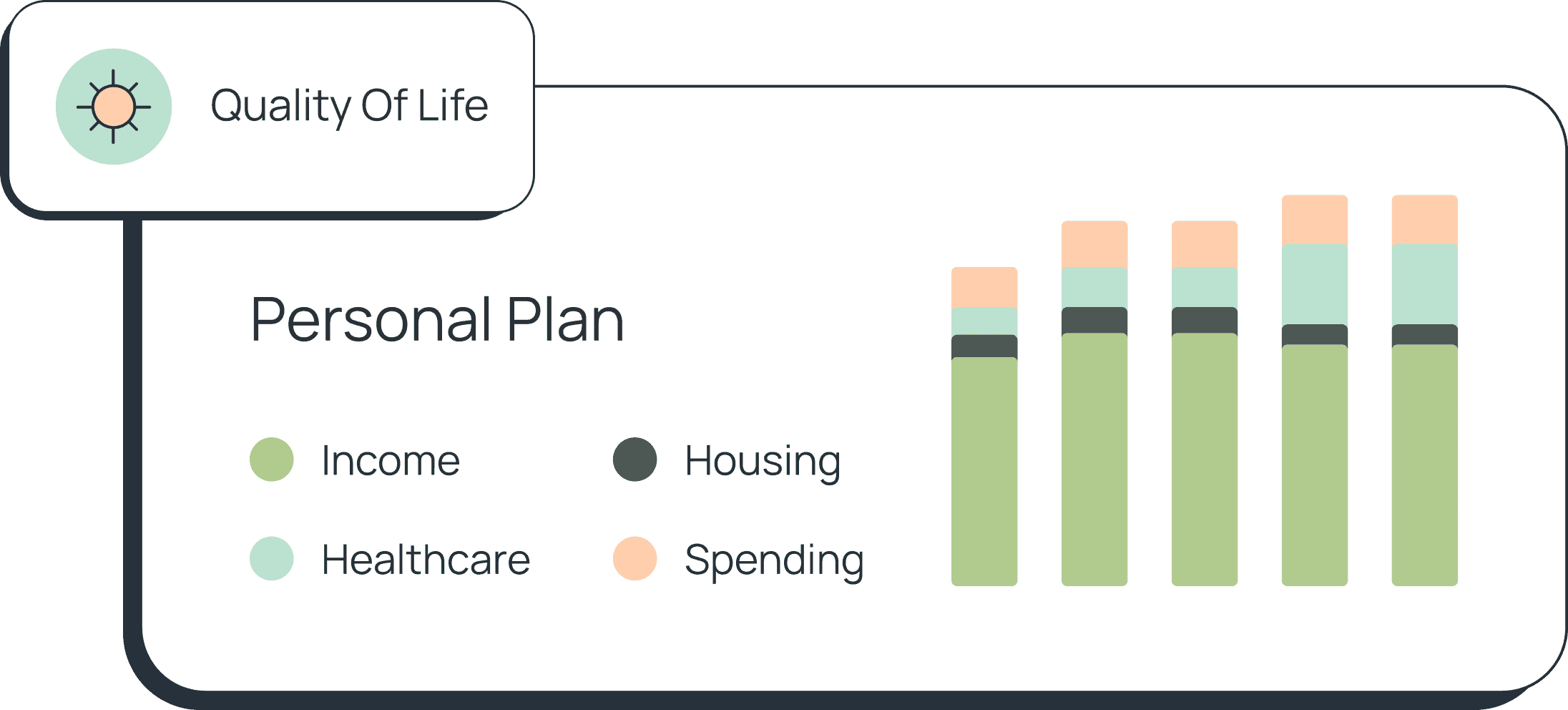Retirement Accounts
In exchange for certain benefits, Roth IRAs come with some special rules, chief of which are income limits.

Harrison Schaefer, CFP®
•
Published January 11th, 2025
•
Updated March 8th, 2025
Table of Contents
Key Takeaways
If you make over a certain amount, this limit might be lowered or you might not be allowed to contribute to a Roth IRA at all.
You can convert a traditional IRA to a Roth IRA to get around these limits.
The maximum you can contribute to a Roth IRA in 2024 & 2025 is $7,000, or $8,000 if you're over 50.
If you’re exploring all of your options for retirement saving, a Roth IRA can sound very appealing. Unlike a traditional IRA, you fund a Roth IRA with post-tax dollars, and don’t take any upfront deduction on it. In exchange, the IRA allows the money inside a Roth IRA to grow tax-free, and in retirement, your withdrawals are tax-free.
Roth IRAs also have other benefits. You can withdraw your contributions penalty-free at any time, no matter how old you are. You also don’t have to take required minimum distributions like you do with traditional IRAs. And unlike a traditional IRA, you can also keep contributing to a Roth IRA after you turn 72.
In exchange for these benefits, Roth IRAs also come with some special rules, chief of which are income limits. If you’re close to retirement, you’ll also want to pay close attention to the five-year rule. In this article, we’ll discuss what those rules are and how to figure out if they apply to you.
While Roth IRAs do have some enticing benefits, they may not be the best option for you and your retirement plan. Depending on how much you earn, the tax deduction you get from a traditional IRA could be worth more to you than the tax-free earnings you get from a Roth IRA. It might also make more sense to use your earnings to pay down debts, as having debts can cost you more in retirement than not having savings. Before contributing to any retirement accounts this year, discuss your financial plan with an advisor.
Roth IRA income and contribution limits for 2025
The maximum amount you can contribute to a Roth IRA in 2024 is $7,000, or $8,000 if you’re age 50, or older. In 2025, this stays the same at $7,000 or $8,000 if you're age 50+. This is a combined contribution limit for all of your IRA accounts, so if you’re contributing to both traditional and Roth IRAs, make sure you’re not putting in more than the max across all of your accounts.
Roth IRAs also have income limits – if you make too much money, your contribution limit might be reduced or you might not be allowed to contribute to a Roth IRA at all.
These limits are based on your modified adjusted gross income (MAGI), which is your adjusted gross income (AGI) with a few deductions added back in. When calculating your Roth IRA income limit, add back in the student loan interest deduction, foreign earned income and housing exclusions, excluded employer adoption benefits, and any deduction you take from contributing to a traditional IRA.
| Filing status | Your contribution limit is reduced if your MAGI is equal to or above: | You can’t contribute to a Roth IRA at all if your MAGI is equal to or above: |
|---|---|---|
| Single, head of household, or married filing separately (if you didn’t live with your spouse during the year) | $150,000 | $165,000 |
| Married filing jointly or qualifying widow(er) | $236,000 | $246,000 |
| Married filing separately (if you lived with your spouse at any point during the year) | $0 | $10,000 |
These limits are raised slightly compared to 2024’s.
Calculate your reduced Roth contribution
If your MAGI falls somewhere between those two limits, your contribution limit is going to be reduced. But by how much? It all depends on where, exactly, you fall between those limits.
Follow these instructions to calculate how much your Roth IRA contribution limit will be reduced:
- Start with your 2025 MAGI.
- Subtract the reduced contribution limit ($150,000 for single filers, $236,000 for joint filers).
- Divide the result by the range between the two contribution limits.
- Multiply it by your maximum contribution limit.
- Subtract the result from your maximum contribution limit.
As an example, let’s say you’re a single filer. First, you need to figure out exactly how much over the contribution limit you are.
Let’s say your MAGI is $152,000 – that puts you $2,000 into the phase-out range, which begins at $150,000 for single filers. Divide that by the $15,000 range to get ~13%. That means you reduce your contribution by 13% of $7,000, which is $910. Your new contribution limit would be $6,090, or $7,090 if you're 50 or older.
Earned income limits
The IRS also rules around what kind of income you can contribute to both traditional and Roth IRAs. Any contribution you make must be from “earned income” – i.e. money that you get from working a job or being unemployed, including wages, bonuses, commissions, tips, or income from owning a business. Other types of income, such as alimony, child support, and unemployment benefits, don’t count. You can’t contribute more than you’ve earned to an IRA, so if you’ve made less than the total contribution limit, that becomes your new contribution limit.
What if you want a Roth IRA but make too much money?
If you want the benefits of a Roth IRA, but make too much money to contribute directly to one, there’s a tax loophole that allows you to convert a traditional IRA to a Roth IRA. It’s called a backdoor Roth IRA. Put money into a traditional IRA account, convert that account into a Roth IRA, and then pay taxes on both the contribution and any investment gains on money in that account up until that point. There are other, administrative rules that you’ll want to follow when you actually go through the process, but it’s otherwise pretty straightforward.
While the benefits of a Roth IRA are hard to ignore, it’s not always a good idea to convert a traditional IRA to a Roth IRA. For starters, if the only way you can pay the taxes due on the conversion is by taking money out of your IRA, this may not be a good idea for you because you’re sacrificing savings and future growth, and if you’re under the age of 59 and a half, you’ll owe an early withdrawal penalty. You’ll also want to be aware of the Roth IRA five-year rule, detailed below.
Make sure to discuss both the pros and cons of a backdoor Roth IRA and how it fits into your overall financial plan with your financial advisor before starting this process.
Timing Roth IRA contributions
The contribution maximum applies to all your IRA accounts—traditional and Roth—so if you contribute $5,000 to one account, you’re only allowed to deposit $1,500 to any other IRA accounts in that tax year.
Contributions to a Roth IRA can be made until the tax filing day of the following year. All of your 2023 Roth IRA contributions, for instance, are allowed until the tax return deadline, which is Monday, April 15, 2024. The deadline is the same even if you get an extension on your taxes.
Roth IRA five-year rule
Generally speaking, anyone (of any age) who contributes to a Roth IRA can withdraw their contributions—not earnings—at any time, without penalty. At age 59 ½, you can also withdraw your earnings; if you withdraw your earnings before then, you will be subject to a 10% early withdrawal penalty. Earnings can be withdrawn after age 59 ½, as long as you meet the Roth IRA five-year rule.
Put simply, the five-year rule states that you cannot withdraw tax-free earnings from your Roth IRA until it’s been five years since your first Roth IRA contribution. This rule applies to everyone who opens a Roth IRA, no matter what your age is.
The five-year clock starts on January 1st of the year of your first contribution, so if you contributed on December 31, 2000, your five years would be up on January 1, 2005. This five-year rule applies to backdoor Roth IRA conversions as well – the clock starts January 1st of the year the conversion happened.
Note, however, that this only applies to the earnings. You can withdraw your original contributions from a Roth IRA at any time without penalty.
Bottom line
Roth IRAs can be a very useful and flexible tool for retirement saving, and if you can contribute to one, you should seriously consider it. However, depending on where you are in your finances and your life, Roth IRAs may not be the best savings tool for retirement, as the benefits of a traditional IRA may be more valuable. Additionally, rules around when you can start withdrawing your tax-free earnings may lock your money up for longer than you intended.
You should also consider how saving fits into your larger retirement plan, as that money may be better spent paying down debts than sitting in investment funds.
Frequently Asked Questions
You asked. We answered.
What happens if I contribute to a Roth IRA but my income is too high?
If your income changes drastically during the year, you might be concerned that you have exceeded the Roth IRA contribution limit. While not ideal, this does happen frequently and the solution is pretty straightforward. All excess contributions are subject to a 6% excise tax for each year they remain in your IRA account, but you can avoid the penalty by withdrawing the excess amount or reclassifying the contributions as traditional IRA contributions before the due date of your tax return. Be sure to discuss the situation with a financial advisor with tax expertise.
Can I open a Roth IRA if I make over 200k?
To qualify for Roth IRA contributions, a single filer’s maximum MAGI (modified adjusted gross income) must be less than $165,000 in 2025. If you are married and filing jointly, your MAGI must be under $246,000 in 2025.
Is there a traditional IRA income limit?
No, there is no maximum income limit for traditional IRAs, though you should note that there is an income limit for deductible contributions if you or your spouse are making contributions via a workplace retirement place. There is no income limit for nondeductible contributions.
Share this advice

Harrison, a Certified Financial Planner® and Senior Financial Advisor at Retirable, has nearly a decade of experience across wealth building, investment advising, and financial education. He prides himself on working one-on-one with each client to help them at every step so they enter retirement with peace of mind.
Understanding 401(k)s
401(k) Rules
Cashing Out your 401(k)
Understanding Roth 401(k)s
Roth IRA Basics
Share this advice

Harrison, a Certified Financial Planner® and Senior Financial Advisor at Retirable, has nearly a decade of experience across wealth building, investment advising, and financial education. He prides himself on working one-on-one with each client to help them at every step so they enter retirement with peace of mind.
Free Retirement Consultation
Still have questions about how to properly plan for retirement? Speak with a licensed fiduciary for free.





